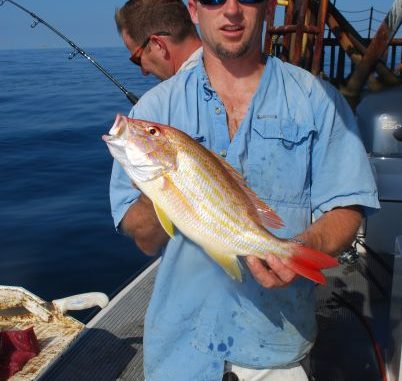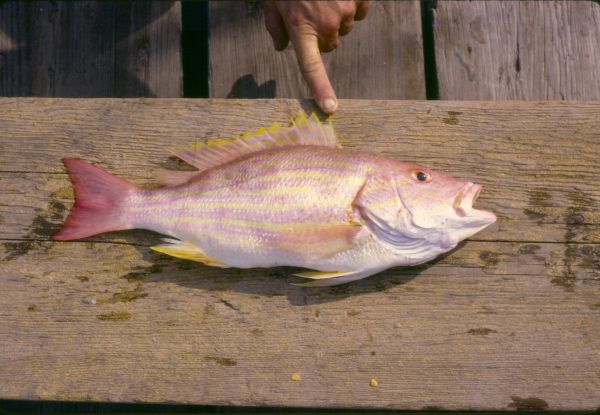
Louisiana’s largest lane outpaces world record
If red and mangrove snappers are the meat and potatoes of the snapper fishing world, then lane snappers are the dessert. Maybe that’s why one of their common names is candy snappers, although it’s probably because they are striped, like a candy cane.
Some references list the lane snapper, Lutjanus synagris, as a fish easy to mistake for a red snapper, although one would have to be nearly blind to do so. While they are pink or orangey-pink in background body coloration, they are striped lengthwise by bold, bright-yellow stripes; their anal and pelvic fins are bright yellow; and their dorsal fins are prominently edged in yellow.
Either blackfin or silk snappers would be much more likely to be misidentified as red snappers than would lane snappers.
Virtually all fish identification guides also show the lane snappers as having a dark spot, verging on black and larger than its eye, located on each side of the fish below the soft (non-spiny) part of the dorsal fin. In reality the spot is often so indistinct as to appear to be a darker pink blotch, or it might be missing altogether, especially on larger fish.
Lane snappers are a bonus fish for red snapper fishermen, another reason to call them the dessert after the main course. They don’t count against the red snapper limit, but rather are part of the aggregate limit.
Lane snappers seem to be everywhere in waters 50 to 100 feet deep (although they have been found out to depths of 1,300 feet) over hard bottoms and reefs, or near offshore oil structures.
Juveniles are found in shallower water — sometimes as shallow as 20 feet — although they are almost never found in inshore bays and lakes as are juvenile mangrove snappers. Nearshore shrimp trawlers often pick them up when trawling over sandy or even muddy bottoms.
Lane snappers are found from Virginia southward, through the northern Gulf of Mexico and the Caribbean, and then down along the coast of South America to southern Brazil. In some parts of their range, they are found in brackish water and over sea grass beds.
Although they are considered an incidental catch — almost a bycatch in the commercial and recreational fisheries of the northern Gulf, they are a targeted species in Cuba and Puerto Rico — where they make up a major part of the catch.

They are excellent table fare, and indeed those taken by commercial fishermen in the Gulf are marketed with red snappers of the same size for the same price.
Lane snappers are willing, almost aggressive feeders. They are less wary of hooks than some other snappers, and will take a variety of fresh, frozen or live baits such as shrimp, squid, cut bait and minnows, and will also take artificial lures if they get a chance.
Lane snappers feed most heavily at night, and various studies show them eating almost anything and everything. A Cuban study showed a diet that was 32 percent fish and 28 percent crustaceans.
A study done in the southern Caribbean was more detailed. It showed that, by weight, 32 percent of their diet was snails and 18 percent was shrimp. By number of items consumed, swimming crabs (like our blue crab) came in first at 25 percent and mantis shrimp were second at 11 percent. The researchers concluded that these four food items were the “main preys,” and that rock shrimp and cutlassfish (ribbonfish or silver eels) were “secondary preys.” Anything else eaten, including squid and other fish species, was classified as “incidental preys.”
By snapper standards, lane snappers are not large fish. A 5-pounder is considered very large. The IGFA world record is an 8-pound-3-ounce fish taken by a Mississippi angler from the Horseshoe Rigs in 2001.
Strangely, the official Louisiana record is much larger, a 12.08-pound leviathan taken from Ship Shoal Blocks in 2009. This fish was either not submitted to the IGFA or was rejected by the group.
There is little reason to suspect the identification of this monster, as the Louisiana Fish Records Program requires a biologist to identify the species and sign off on it.
Lane snappers grow fast and mature early, although they can live as long as 19 years. Some studies note that they can become sexually mature at small as 3 inches long. All agree that lane snappers can spawn by 9 inches in length. At this size, they are typically age-1 or at most age-2 fish.
Lane snappers are not a heavily researched fish, but scientists with the National Marine Fisheries Service did conduct an age-and-growth study on the species in the mid-1990s.
A total of 826 lane snapper (45 from Texas, 471 from Louisiana and 310 from Florida) were obtained from hook-and-line fishermen. The fish were aged by counting the rings in their otoliths (ear bones), and their growth rates were calculated.
They found that male lane snapper grew slightly faster and were larger at each age than females; however, the oldest and largest fish were females.
The oldest fish was a 17-year-old female that was 20 inches long. The largest fish was a 27-inch female that was 11 years old.
Their spawning season is extended over several months. Some research indicates that spawning starts as early as March; other research shows a May onset. All agree that spawning ends in September.
The eggs are pelagic, meaning they are free-floating and at the mercy of water currents. Hatching occurs within 23 hours.
Research also shows there are two genetically distinct stocks of lane snappers in the northern Gulf of Mexico. The western group ranges from South Texas through Alabama. The eastern group ranges on both the western and eastern coasts of the Florida Peninsula.
A recent study also indicates that the Florida group is distinct from those of the U.S. Caribbean.


